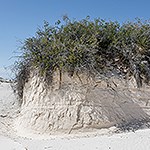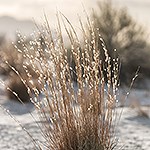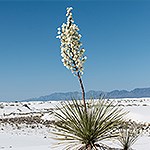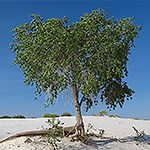
NPS Photo
Life as a plant in the dune fields of White Sands is really rough. Plants must be able to withstand the climatic conditions of the Chihuahuan Desert, adapt to a constantly shifting landscape, and must be successful in finding sources of water and nutrients, which can be very difficult in the sterile, gypsum sand. As a result of these harsh living conditions, only a few plants can call the White Sands gypsum dunefield home. These plants have adapted to their environment and developed special survival strategies in order to thrive in this glistening landscape.

NPS Photo Hold on is what a few plants do in order to survive in the ever-shifting sands. Shrubs and trees survive by “holding on”, using their compacted root structure. Their roots tap all the way down into the water table and absorb water. When the root system transports the ground water, some of the water gets absorbed into the surrounding sand. This process forms a hard mound, called a pedestal. The pedestal encases the root structure and stabilizes the plant. When the dune has moved on, we can see the pedestals that were left behind. Examples of plants that employee the hold on method of survival include the Skunkbush Sumac (Rhus trilobata) and Hoary Rosemary Mint (Poliomintha incan). 
NPS Photo Grow fast is what a few plants do in order to beat the progressing dunes. Located in the interdunal areas of the monument, grasses flourish on the cryptobiotic soil crust. This biological soil crust provides nutrients for the plant and promotes their rapid growth. These grasses rely heavily on rapid growth, pollination, and the forward direction of wind movement for seed dispersion. As new grasses are growing, older grasses are becoming engulfed in the advancing dunes. Their motto is “Live fast, die young”. Example of plants that use that grow fast to survive in the dunefield include Alkali Sacaton (Sporobolus airoides), Indian ricegrass (Achnatherum hymenoides), and little bluestem (Schizachyrium scoparium). 
NPS Photo Grow tall is what some plants do to survive in the gypsum dunefield. At White Sands, the only plant that uses this survival strategy is the soaptree yucca (Yucca elata). This plant uses stem elongation, which is the extension of its stem used to stay above the dune. Yuccas can reach up to 30 feet (9 m) tall. When the dune moves on, the long stem of the plant can no longer be support and topples over. From these collapsed stems, new side shoots reproduce and new life begins for the plant. 
NPS Photo Grow on is what some plants must do in order to survive in the desert conditions of the dunefield. The Rio Grande cottonwood (Populus deltoides wislizeni) tree is known to use this survival strategy to accommodate to life at White Sands. The cottonwood tree requires plenty of water, and thrives in the park as evidence of our elevated water table. Once the tree absorbs all of the water from the dune, the roots continue growing deeper and deeper chasing after the fluctuating water table. The Rio Grande cottonwood also puts out new plants from the same root system. What may appear to look like several individual trees may in fact be several trees living off one root system. |
Last updated: January 22, 2020
